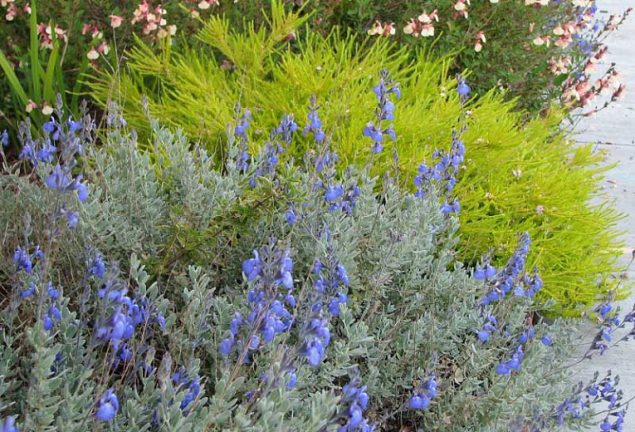Salvia chamaedryoides is also known as a germander sage. It is an evergreen sub-shrub or perennial, native to an elevation of 2100 to 2800 meters or the high desert of the Sierra Madre Oriental range in Mexico. The name of Salvia Chamaedryoides is derived; from the fact that it shares the running rootstock typical of Teucrium chamaedrys (wall germander). This sub-shrub bears flowers on it, having a color of blue that appears sporadically. The peak of the blooming season is usually visible in early autumn and summer. The nature of Salvia is a spreading and dense mounding one. The sub-shrub has already grown since the early 19th century in European horticulture. However, it was only introduced in the 1980s to the U.S. The Salvia usually grows up to 12 to 18 inches tall and 3 to 4 feet wide; it spreads slowly and outwardly from the shoots from a spreading rootstock.
Salvia Chamaedryoides Propagation
The propagation of Salvia chamaedryoides may be carried out by the following methods; cutting, dividing, and sowing of seeds.
To begin propagation by cutting, use isopropyl alcohol to disinfect a pair of gardening shears. Then, cut the stem region up to 5 to 8 inches below either of the nodes. Then, place the fragment in a glass containing 3 inches of water and keep the glass in a spot with filtered light. When the roots become an inch long, the cutting is readily transplanted.
The second way to cause propagation is to divide the mature plant. Divide first the plant after flowering; the next step is to cut the plant back and dig the soil around the plant’s base. Divide the plant into two to three sections such that each of the sections contains several roots. Wrap the divided sections; in a damp newspaper and transplant those sections to their new homes.
Salvia Chamaedryoides Seeds
A Mexican blue sage or blue oak sage is versatile shrubs having blue and vibrant flowers. The shrub is catchy to the eye of a gardener. For this reason, it is highly used; to serve ornamental purposes. Now, how can the Salvia shrub be propagated employing its seeds?
Salvia can be directly seeded indoors or in a flower garden for transplanting later. A few varieties of Salvia require light for germination and the seed spreading upon the soil’s top. Remember to water lightly as the rapid washing may wash the seeds away or cause them to penetrate deep into the soil. Transplant Salvia after the last frost date according to your area. Give Salvia Chamaedryoides sufficient room to spread and show their beautiful blooms. They are approximately 10 to 20 inches apart.
Salvia Chamaedryoides Care
If an individual intends to grow Salvia Chamaedryoides, he should always keep in mind the point of its origin, which is the altitude desert located in its native Mexico. Once the above-mentioned fact is clear, it is straightforward also to care for the shrub to help it attain optimum growth. The care of Salvia usually mentions two points. That is, the addition of a small amount of water and cutting of it whenever integral, and the shrub is good to go.
Salvia shrubs must be exposed; to full sun for long hours; however, it is also capable of tolerating a small portion of sunlight. Similar water and humidity conditions may be provided by not watering the shrub in fall or winter. Another thing necessary for its care is to maintain well-drained soil, that is, moderately fertile, free-draining chalky, sandy, or loam. The use of fertilizer is also essential in spring/summer.
Salvia Chamaedryoides Pruning
Pruning of any shrub is necessary to maximize its life cycle. Now, how to prune Salvia Chamaedryoides? Salvia is an evergreen shrub; for this reason, it is pruned like any other ordinary evergreen shrub.
When pruning an evergreen shrub, always object to remove approximately one-third of the older wood portion. Look out for the presence of any diseased, damaged, or dead shoots with the help of long-handled loppers or a saw if needed. Finally, the thinning of packed shoots and poorly positioned ones, responsible for the spoiling of the shrub’s appearance, take place Once the pruning is completed, the shrub takes full advantage of feeding and mulching. A general-purpose fertilizer, specialist rose, or other high potassium fertilizers are used. The suitable time for pruning is just before the starting of mid-spring after the risk of frost is upheld. However, those evergreens that are in the notion of flowering are left; until the completion of flowering.



